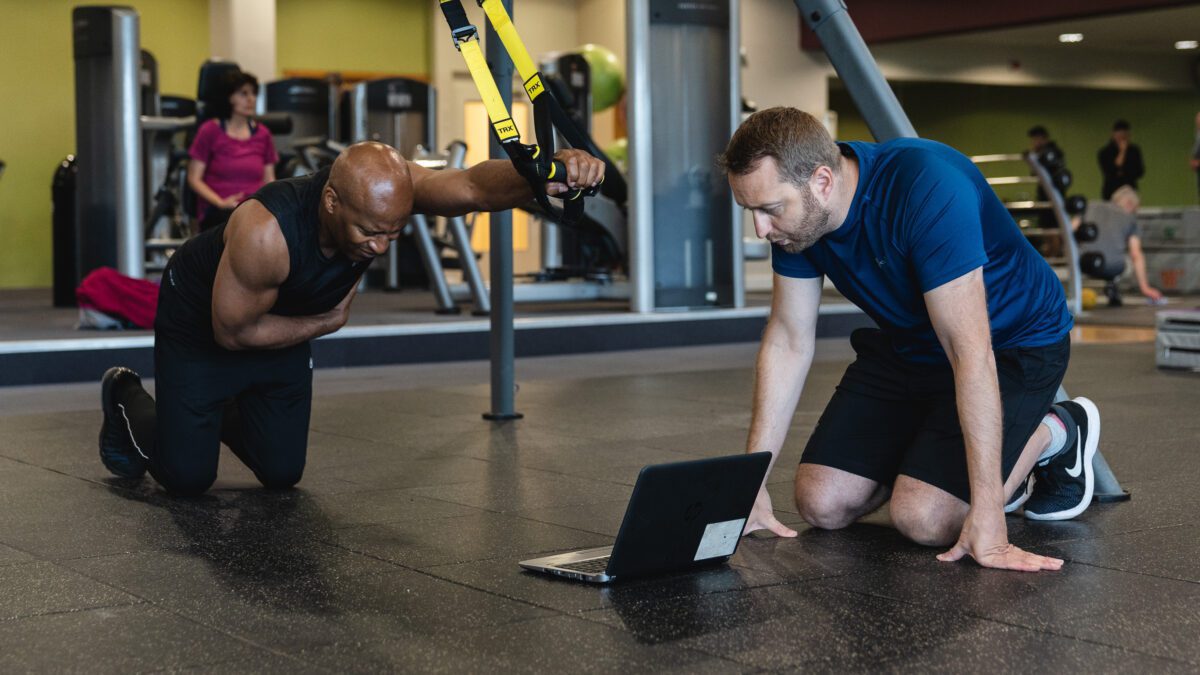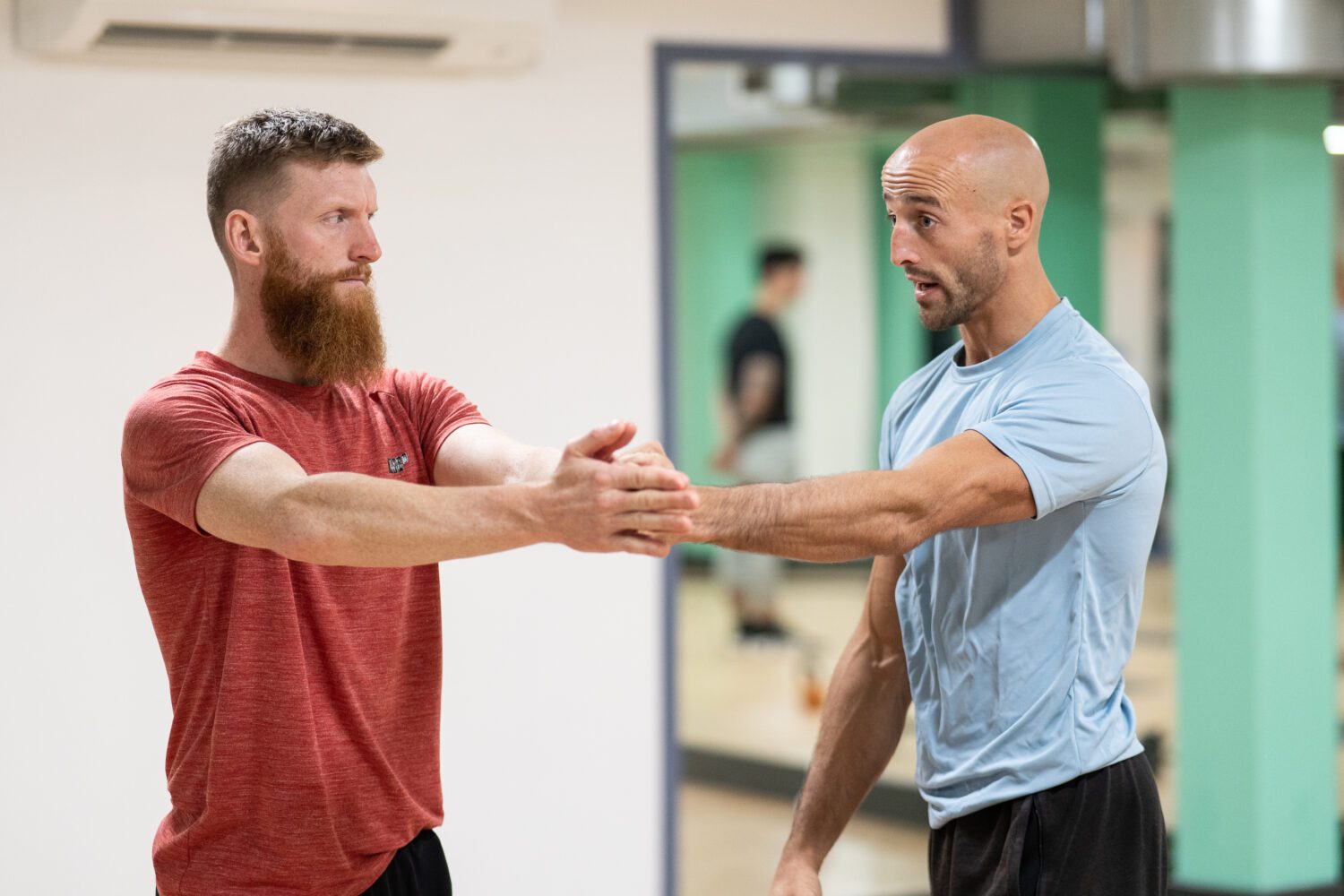** Fitness Instructor and Personal Trainer ** A fitness instructor leads group exercise classes, while a personal trainer provides one-on-one training sessions. Both roles focus on improving physical fitness but differ in their methods.
A fitness instructor typically works with larger groups, guiding participants through structured workouts. They often teach classes like yoga, spinning, or aerobics, emphasizing form and safety. Personal trainers, on the other hand, tailor fitness programs to individual clients, considering their specific goals and needs.
They offer personalized feedback, adjust exercises, and track progress closely. Both professions require knowledge of exercise science, but personal trainers often have more in-depth training. Whether you prefer a group setting or individual attention, understanding these roles helps in choosing the right fitness path.

Credit: jameslshapiro.com
Introduction To Fitness Roles
Understanding the roles of a Fitness Instructor and a Personal Trainer can help you choose the right fitness professional. Both play crucial roles in the world of fitness, but their responsibilities and skills differ.
Fitness Instructor Attributes
A Fitness Instructor leads group exercise classes. They focus on teaching and demonstrating exercises. Their main goal is to ensure the safety and effectiveness of group workouts.
- Group Class Leadership: Fitness Instructors guide multiple participants.
- Exercise Demonstration: They show the correct way to perform exercises.
- Safety Focused: Ensuring participant safety is their priority.
- Motivational Skills: They keep the group energized and motivated.
Personal Trainer Qualities
A Personal Trainer works one-on-one with clients. They design personalized workout plans tailored to individual goals. Their focus is on personal fitness development and achieving specific outcomes.
- Individual Attention: Personal Trainers provide customized guidance.
- Personalized Plans: They create workout plans based on client needs.
- Goal-Oriented: Helping clients achieve their fitness goals is key.
- Progress Tracking: They monitor and adjust plans based on progress.
| Aspect | Fitness Instructor | Personal Trainer |
|---|---|---|
| Client Interaction | Group Setting | One-on-One |
| Focus | Group Safety and Motivation | Individual Goals and Progress |
| Training Plans | Generalized | Personalized |
Certifications And Education
Certifications and Education play a crucial role in defining the expertise and credibility of fitness professionals. Both fitness instructors and personal trainers need proper qualifications to provide effective guidance. This section will explore the standard credentials and educational paths required for both roles.
Standard Credentials For Fitness Instructors
Fitness instructors generally work in group settings. They lead classes such as aerobics, spin, or yoga. To become a fitness instructor, certain certifications are essential.
- Aerobics and Fitness Association of America (AFAA): This certification is well-recognized and covers a wide range of fitness activities.
- American Council on Exercise (ACE): ACE offers a Group Fitness Instructor certification that is highly regarded.
- National Academy of Sports Medicine (NASM): NASM’s Group Fitness Instructor certification is also a popular choice.
Besides certifications, fitness instructors often hold CPR and First Aid certifications to ensure safety during classes. They usually attend workshops and continue education courses to stay updated.
Certification Path For Personal Trainers
Personal trainers work one-on-one with clients. They create personalized fitness plans and monitor progress. The certification process for personal trainers is more extensive.
- National Strength and Conditioning Association (NSCA): The Certified Personal Trainer (CPT) credential is highly respected.
- American College of Sports Medicine (ACSM): ACSM offers a Personal Trainer certification known for its rigorous standards.
- International Sports Sciences Association (ISSA): ISSA’s Personal Trainer certification is widely accepted.
Personal trainers often hold a bachelor’s degree in exercise science or a related field. They must also maintain CPR and First Aid certifications and complete continuing education to keep their credentials current.
| Role | Key Certifications | Additional Requirements |
|---|---|---|
| Fitness Instructor | AFAA, ACE, NASM | CPR, First Aid, Continuing Education |
| Personal Trainer | NSCA, ACSM, ISSA | Bachelor’s Degree, CPR, First Aid, Continuing Education |
Scope Of Practice
Understanding the scope of practice for fitness professionals can help you choose the right support for your fitness goals. Fitness instructors and personal trainers both aim to improve your health, but they do so in different ways.
Group Dynamics And Fitness Instructors
Fitness instructors typically lead group exercise classes. They create a fun and energetic environment. This setting encourages participants to stay motivated.
Fitness instructors design workouts that cater to various fitness levels. They aim to keep everyone engaged. Common classes include yoga, Zumba, and spin classes.
A fitness instructor must have excellent communication skills. They need to give clear instructions and demonstrate exercises effectively.
One-on-one Focus Of Personal Trainers
Personal trainers work with clients on a one-on-one basis. They tailor fitness programs to meet individual needs and goals. This personalized approach helps clients achieve specific outcomes.
A personal trainer provides customized workouts and nutritional advice. They monitor progress closely and adjust plans as needed.
Personal trainers often work in gyms or private settings. They may also offer online coaching. Their primary focus is to ensure that each client reaches their personal fitness goals.
Typical Responsibilities
Understanding the typical responsibilities of a fitness instructor and a personal trainer can clarify their roles. While both professionals aim to help people achieve their fitness goals, their methods and responsibilities differ.
Class Design And Instruction
Fitness instructors often lead group exercise classes. They create and follow structured workout routines. These routines include warm-ups, main workouts, and cool-downs. Instructors need to keep the class engaging and safe. They demonstrate exercises and ensure participants use proper form. Fitness instructors also motivate the class and adjust exercises for different fitness levels.
Personal trainers focus on one-on-one sessions. They design personalized workouts for each client. These plans consider the client’s goals, fitness level, and any injuries. Personal trainers demonstrate exercises and correct their client’s form. They provide motivation and support throughout the session.
Customized Fitness Plans And Coaching
While both roles involve creating workout plans, the personal trainer’s approach is more individualized. A personal trainer conducts fitness assessments to understand the client’s needs. Based on these assessments, they create a customized fitness plan. This plan includes specific exercises, sets, and repetitions. Personal trainers also adjust plans as clients progress.
Fitness instructors usually follow a set routine for their classes. They may design these routines themselves or follow a program provided by their employer. While they can suggest modifications for individuals, the overall plan is meant for the group. Their focus is on keeping the class energetic and enjoyable.
| Role | Focus | Responsibilities |
|---|---|---|
| Fitness Instructor | Group classes |
|
| Personal Trainer | Individual sessions |
|
Expertise And Specialization
Understanding the difference between a fitness instructor and a personal trainer can be confusing. Their roles overlap, but their expertise and specialization set them apart. This section will shed light on their unique skills and knowledge.
Broad Knowledge For Instructors
Fitness instructors possess a broad understanding of various exercise routines. They guide groups through workouts and ensure everyone stays safe. Their training covers general fitness principles, enabling them to teach different classes like aerobics, yoga, or spinning.
They focus on keeping the group engaged and motivated. Their goal is to provide a fun and effective workout for all skill levels.
In-depth Expertise For Trainers
Personal trainers, on the other hand, have in-depth expertise in specific fitness areas. They create customized workout plans tailored to individual needs. Their training goes beyond general fitness; they often specialize in areas like weight loss, muscle building, or rehabilitation.
They assess clients’ fitness levels, set goals, and track progress. They also provide nutritional advice and lifestyle recommendations.
Personal trainers build strong relationships with their clients. They offer one-on-one guidance and support to help clients achieve their fitness goals.

Credit: www.futurefit.co.uk
Client Interaction And Relationship
Understanding the client interaction and relationship between fitness instructors and personal trainers is crucial. This connection can greatly influence your fitness journey and overall experience.
Motivating Classes
Fitness instructors often lead group classes. Their goal is to keep the entire class engaged and motivated. They use energetic music and dynamic routines to inspire the group. This environment can help you push harder and enjoy the workout.
Instructors focus on the group’s energy and performance. They make sure everyone stays safe and follows the routine. They offer general guidance and corrections to improve form. The class vibe is often upbeat and encouraging.
Personalized Guidance
Personal trainers work one-on-one with clients. They create personalized workout plans tailored to your goals and needs. This individualized approach ensures you get the most out of each session.
Trainers spend time understanding your strengths, weaknesses, and preferences. They offer customized advice and adjustments. This helps you perform exercises correctly and avoid injuries. You receive constant feedback and support, making your fitness journey more effective.
To summarize:
| Aspect | Fitness Instructor | Personal Trainer |
|---|---|---|
| Focus | Group engagement | Individual needs |
| Guidance | General | Personalized |
| Feedback | Group-based | One-on-one |
Understanding these differences helps you choose the right professional for your fitness goals. Whether you thrive in a group setting or need personalized attention, both fitness instructors and personal trainers offer valuable support.
Employment Settings
Understanding the employment settings of fitness instructors and personal trainers can help you decide which career path suits you. While their roles may seem similar, their work environments can differ significantly.
Gyms And Studios For Instructors
Fitness instructors often work in gyms and fitness studios. These environments are equipped with various facilities and classes. They may teach group classes, including yoga, spin, or aerobics. Instructors usually follow a set schedule and work with many participants at once.
Gyms and studios provide a structured environment. Instructors have access to equipment and space needed for classes. The structured schedule helps in maintaining a routine. The gym or studio usually handles membership and marketing.
| Pros | Cons |
|---|---|
| Access to ample equipment | Structured schedules may limit flexibility |
| Opportunity to work with groups | Less personalized attention to individuals |
| Employer handles marketing | Set class times may vary |
Diverse Opportunities For Trainers
Personal trainers have diverse job opportunities. They can work in gyms, clients’ homes, or outdoor settings. This flexibility allows them to tailor their services to individual clients.
Trainers can also offer online sessions, expanding their client base. They can work independently or be employed by fitness centers. This variety helps trainers meet specific client needs and schedules.
- Flexible work environments
- Potential for higher earnings
- Personalized client programs
- Online training options
Personal trainers enjoy more flexibility and personalization. They can create custom fitness plans for each client. This personalized attention can lead to better client results and satisfaction.
While both fitness instructors and personal trainers have unique work settings, understanding these differences can help you choose the right career path.
Career Path And Progression
Understanding the career path and progression for fitness instructors and personal trainers can help guide your career decisions. Both roles have unique opportunities for growth. Let’s explore the potential and advancement opportunities in these fields.
Potential For Instructors
Fitness instructors usually start by teaching group classes. They can specialize in areas like yoga, aerobics, or spin classes. Over time, they may gain experience and reputation.
As they progress, they can lead multiple classes at different gyms. Some instructors even open their own studios. They can also become certified in multiple disciplines to attract more clients.
Another option is to create online fitness programs. This allows instructors to reach a global audience. It’s a great way to diversify income streams.
Advancement For Trainers
Personal trainers often start by working one-on-one with clients. They create customized fitness plans and track progress. With experience, they can charge higher rates and work with more clients.
Some personal trainers specialize in areas like sports conditioning, rehabilitation, or nutrition. Specialization allows trainers to offer unique services and stand out.
As they gain a reputation, personal trainers can move into managerial roles. They might oversee other trainers at a gym or fitness center. Another option is to start their own personal training business.
Additionally, trainers can expand their services online. Offering virtual training sessions can reach a broader audience. It’s a flexible way to increase income.
| Role | Starting Point | Advancement Opportunities |
|---|---|---|
| Fitness Instructor | Teaching group classes | Specializing, leading multiple classes, online programs |
| Personal Trainer | One-on-one training | Specializing, managerial roles, online training |
Both career paths offer growth opportunities and ways to increase earnings. Whether you choose to be an instructor or trainer, there are many avenues to explore.
Choosing The Right Path
Choosing between becoming a fitness instructor or a personal trainer can be challenging. Both careers offer unique opportunities. But they also come with different responsibilities. Understanding these differences can help you make an informed decision.
Assessing Your Fitness Career Goals
Fitness instructors usually lead group classes. These classes include yoga, Zumba, or spinning. They must be energetic and able to motivate many people at once. Personal trainers, on the other hand, work one-on-one with clients. They create tailored workout plans and provide individual guidance.
Think about what kind of environment you want to work in. Do you thrive in a group setting? Or do you prefer a more personal approach? Your career goals should align with your preferred work environment.
Matching Skills And Interests
Fitness instructors need strong public speaking skills. They must be able to engage a crowd and keep the energy high. They also need a good understanding of choreography and exercise routines.
Personal trainers require excellent communication skills. They must be able to explain exercises clearly. They also need to understand each client’s unique needs and goals. This role often involves more in-depth knowledge of fitness and nutrition.
Consider your skills and interests. Are you passionate about leading groups or working with individuals? Do you enjoy creating personalized fitness plans or teaching a set routine to a group? Answering these questions can help you choose the right path.
| Aspect | Fitness Instructor | Personal Trainer |
|---|---|---|
| Work Environment | Group Classes | One-on-One Sessions |
| Skills Required | Public Speaking, Choreography | Communication, Personalized Planning |
| Client Interaction | Motivate Groups | Individual Guidance |
- Fitness Instructors lead group classes.
- Personal Trainers work one-on-one with clients.
- Consider your environment preference.
- Assess your skills and interests.

Credit: www.futurefit.co.uk
Frequently Asked Questions
Is A Fitness Coach The Same As A Personal Trainer?
A fitness coach focuses on overall wellness and motivation. A personal trainer designs specific workout plans and techniques. Both roles can overlap.
What Can A Fitness Instructor Do?
A fitness instructor designs workout plans, leads exercise classes, and offers personalized fitness advice. They ensure proper technique, motivate clients, and track progress.
What Is The Difference Between A Fitness Instructor Specialist And A Personal Trainer?
A fitness instructor specialist leads group classes and provides exercise guidance. A personal trainer offers one-on-one fitness coaching and personalized workout plans.
What Is The Difference Between A Trainer And An Instructor?
A trainer focuses on skill development and practical application. An instructor provides knowledge and theoretical understanding. Both aim to educate, but their approaches differ.
Conclusion
Understanding the roles of fitness instructors and personal trainers is key. Fitness instructors guide groups, while personal trainers offer one-on-one support. Both play vital roles in achieving fitness goals. Choosing the right professional depends on your personal needs and preferences.
Prioritize your fitness journey with the right guidance for optimal results.

“As the voice behind Radiant Glow Health, we are dedicated to being your ultimate wellness and vitality companion. Our mission is to inspire and guide you on your journey to a healthier and more vibrant life. Join us as we explore holistic health practices and empower you to radiate wellness from within.”



